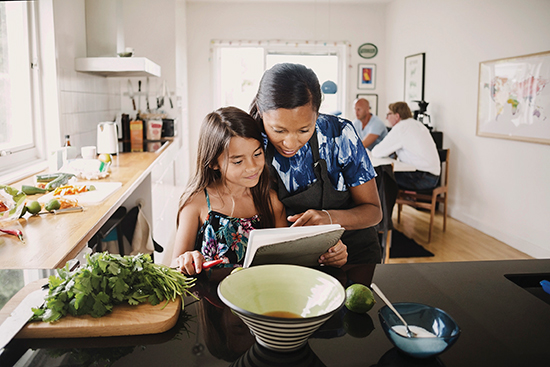
At-Home Learning Throughout Summer
Tips for keeping students sharp over the long-haul
With the majority of schools across the country closed, many parents are feeling the stress of taking more active roles in their children’s education. As time away from the classroom extends into summer, parents also face the challenge of helping their children maintain what they’ve learned through a summer of uncertainty.
This year’s shift to at-home learning has provided plenty of resources parents can use to keep their children’s minds engaged and actively learning. The shift has also prompted families to create new routines and healthy learning habits. Continuing these best practices over the summer may prove beneficial in setting students up for success when they return to the classroom.
- Set a clear daily schedule with realistic goals and be sure to allow flexibility. A child’s attention span grows longer with age – typically 2-3 minutes per year of age – so the amount of time an elementary school student will focus on a task may be significantly shorter than a high school student.
- Build in time for kids to play. According to the journal, “Pediatrics,” playing promotes healthy brain development and boosts academic skills. Play time also helps children manage stress – making it an important and fun way for parents to support kids coping with stress or anxiety.
- Create a conducive learning environment at home. If possible, set up a designated desk and distraction-free workspace children can use for everything from completing school assignments to playing educational games.
While routines are important, they may not be the only key to summer learning success. Research from Harvard indicates parents who engage with their children in simple activities over the summer – like reading together or talking about baseball statistics – can have a greater impact on their children’s academic performance than popular summer activities, such as summer camps, travel or summer school.
Since education can happen anywhere as part of everyday life, there are many activities families can do together to create a sense of summertime fun while fostering academic growth.

- Spend some time cooking or baking together. Use these experiences as opportunities to practice reading recipes or practice math by measuring and adding ingredients.
- Work with other parents or family members to find summer pen pals. Have kids write letters back and forth to practice reading and writing skills.
- Extend story time with read-and-do activities that lay the groundwork for developing engaged readers. For example, the Pizza Hut BOOK IT! Program offers free online activities at bookitprogram.com children and parents can do together, such as drawing, letter recognition or sight-word bingo.
- Explore science and nature by taking a walk. Try and identify different types of clouds, trees, plants, rocks and animals. Take pictures of any you find interesting. Then look up additional information when you return home to practice research skills.
- Watch the news or read about current events together. This can provide practical lessons on social studies and help kids raise questions about the world around them.
ABCs of Combating Summer Slide
While on summer break, kids commonly lose some of the learning momentum from the previous school year. It’s a phenomenon casually referred to as the “summer slide.”
A report from the Northwest Evaluation Association found students in third-fifth grades lost about 20% of their school-year gains in reading and 27% in math, on average, during summer break.
After such an abrupt end to formal curriculum, the slide could be a little steeper for kids in the fall. However, summer plans for families likely look different this year. More free time may make it easier to build in time for educational activities, which can also offer an escape during this uncertain time.
Allow for reading aloud. According to the National Association for the Education of Young Children, reading aloud is the single most important activity for reading success as it helps build word-sound awareness. Encourage your child to play teacher and read aloud books, magazines, or comics to family members, pets or even stuffed animals.
Begin a book club. Read the same books as your children then discuss what you all read over a shared snack or gathered around the dinner table. Joining in shows the importance of prioritizing reading during the summer.
Check into services offered by libraries. If possible, make use of local libraries, many of which offer free online resources and have extended due dates. Inquire about online services offered in your area and how your family can participate in programs taking place over the summer.
Where and How to Access Online Resources
From educators helping their students to organizations lending support in trying times, dozens if not hundreds of online resources have emerged to help parents navigate teaching at home.
Internet Access: While many at-home learning resources can be found online, some families lack access to reliable and affordable internet connections. For information on free or low-cost home internet access, as well as other resources for teachers and families, visit firstbook.org/coronavirus-educator-resources.
Online field trips: While school and family outings are limited, it’s still possible to explore the world from the comfort of home. Zoos, museums and other places of interest are sharing everything from educational videos and live webcams to guided tours on their websites and social media.
Reading programs: Literacy is the foundation for all learning, so focusing on activities that promote reading gives children a chance to practice that essential skill, often in ways that don’t feel like learning. One resource is The Pizza Hut BOOK IT! Program, the nation’s largest and longest-running corporate-supported reading program. Parents can visit bookitprogram.com to find a number of activities designed to help children find joy in reading. Resources include book recommendations, activity and book pairings, video messages from best-selling authors Tom Angleberger and Kate DiCamillo and printable worksheets, story maps and more.
Educational websites: Many academic websites have opened their subscription-based content for free or reduced access. You can find videos, interactive programs, lesson plans and more. Before creating an account, check if your school has secured free or discounted access codes.
New skills: From learning the basics of keyboard typing to trying a new instrument or mastering a new language, there are sites dedicated to helping students develop new skills while they’re at home.
Source:
Pizza Hut BOOK IT!

